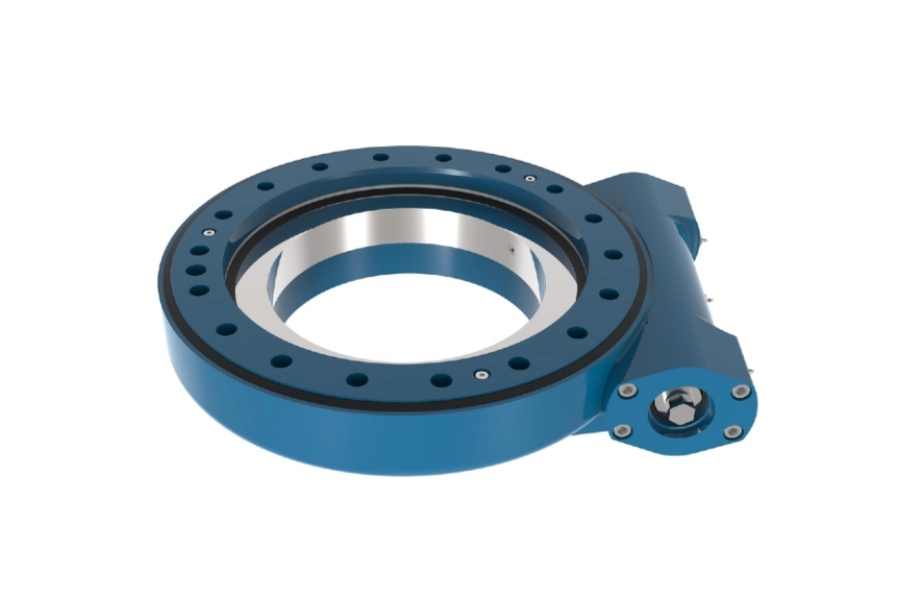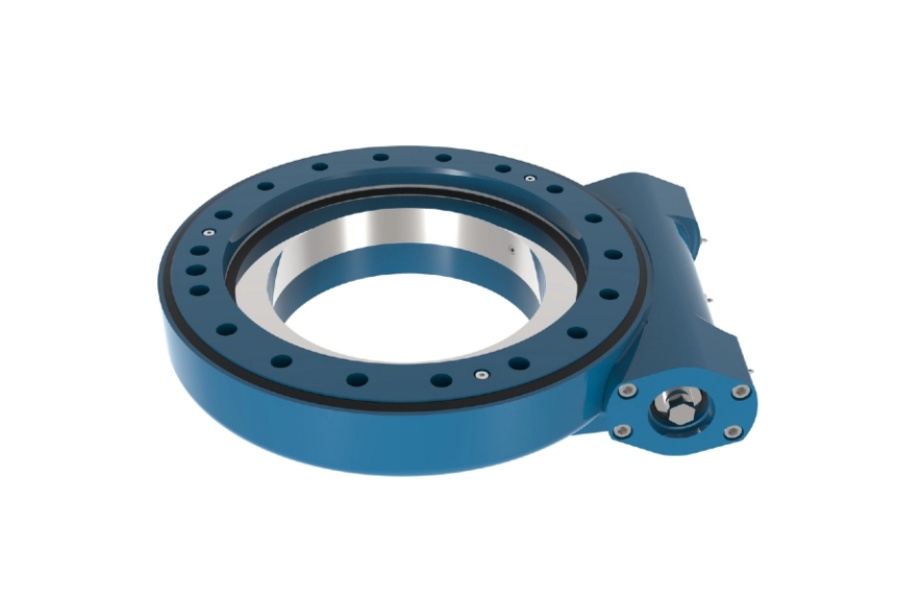
Slew Drive Lubrication Importance
What is Slew Drive
Slew Drive represents an integrated mechanical system that combines a slewing bearing with a worm gear or other drive mechanism to facilitate controlled rotational movement under significant load conditions. This complete assembly incorporates all necessary components including gears, bearings, seals, and mounting interfaces into a single compact unit, providing exceptional structural integrity and operational efficiency. The fundamental purpose of a slew drive is to convert input power from various sources into precise output rotation while simultaneously supporting substantial axial, radial, and moment loads. This integrated approach to rotational power transmission has become essential across numerous industries where space constraints, precision requirements, and reliability are paramount concerns. Proper lubrication maintenance forms the foundation of ensuring these systems achieve their designed performance characteristics and operational lifespan.

Why Timely Lubrication is Crucial for Slew Drive Operation
The importance of proper and timely lubrication for slew drives cannot be overstated, as it directly influences virtually every aspect of system performance, service life, and operational reliability across various applications and environmental conditions.
Lubrication serves as the primary defense mechanism against wear and component degradation in slew drive systems. The continuous rotational movement under heavy loads generates tremendous pressure and friction between mating surfaces, particularly in the worm gear and slewing bearing interfaces. Without adequate lubricant film separation, metal-to-metal contact occurs, leading to rapid wear, surface scoring, and eventual component failure. The lubricant forms a protective barrier that minimizes direct contact between moving parts, significantly reducing friction coefficients and preventing adhesive wear mechanisms that would otherwise destroy precision gear surfaces within relatively short operational periods.
Heat management represents another critical function of proper lubrication in slew drives. The significant friction generated during operation, particularly under heavy loads and continuous operation, produces substantial thermal energy that must be effectively dissipated to prevent component damage. Lubricants absorb and transport heat away from critical contact areas, distributing thermal loads throughout the system and facilitating heat transfer to the housing and external environment. This cooling function becomes particularly important in high-cycle applications or environments with elevated ambient temperatures where thermal overload could lead to material softening, distortion, or complete seizure of moving components.
Corrosion protection constitutes an essential benefit provided by effective lubrication practices. Slew drives often operate in challenging environments where exposure to moisture, chemicals, and other corrosive elements can compromise component integrity. Lubricants create protective coatings on metal surfaces that prevent direct contact with corrosive agents, while specialized additives provide additional chemical protection that preserves component surface properties. This protective function maintains dimensional stability and surface characteristics that are essential for maintaining precise gear meshing and rotational accuracy throughout the system's operational life.
Contamination control represents another vital aspect of lubrication system performance. Lubricants act as cleaning agents that suspend and transport wear particles and foreign contaminants away from critical contact areas, preventing abrasive damage that would otherwise accelerate component wear. The continuous circulation of lubricant through gear meshing areas facilitates the removal of microscopic particles that could initiate surface damage, while filtration systems in advanced lubrication designs maintain fluid cleanliness that extends component life significantly beyond what would be achievable without proper contamination management.
Sealing enhancement completes the comprehensive benefits provided by proper lubrication practices. Lubricants maintain seal flexibility and prevent drying or cracking that could compromise environmental protection. Additionally, the presence of adequate lubricant at seal interfaces reduces friction and wear on sealing elements, maintaining their effectiveness in excluding contaminants while retaining lubrication within the system. This sealing support function becomes particularly important in applications where environmental challenges including dust, moisture, or chemical exposure could rapidly degrade system performance if contaminants enter the internal components.
Characteristics of Slew Drive
Slew drives possess distinctive characteristics that make them indispensable for heavy-duty rotational applications while simultaneously demanding careful attention to lubrication requirements. Their most significant feature is their integrated design philosophy, which combines multiple functional components into a single compact unit, providing substantial space savings and structural simplicity compared to traditional separate systems. These drives deliver exceptional load-handling capability, simultaneously managing complex load combinations including axial forces, radial loads, and moment loads through robust construction and precision-engineered components. The precision positioning capability represents another critical characteristic, with many systems achieving positioning accuracy within arc-minute ranges through precision gearing and minimal backlash design. Durability is enhanced through the use of high-strength alloy steels, advanced heat treatment processes, and comprehensive sealing systems that ensure reliable performance in demanding industrial environments. The modular design approach facilitates easier installation and maintenance, with standardized mounting interfaces and accessible service points that simplify integration and upkeep while reducing total cost of ownership.
Applications of Slew Drive
The unique combination of strength, precision, and compactness enables slew drives to serve critical functions across numerous industrial sectors and applications, each presenting distinct lubrication challenges and requirements. In renewable energy applications, they form the core component of solar tracking systems, precisely orienting photovoltaic panels to maximize energy capture throughout the day, while also serving in wind turbines for pitch and yaw control mechanisms that optimize performance and protect against extreme weather conditions. Construction equipment extensively utilizes slew drives in excavators, cranes, and aerial work platforms, where they provide the rotational capability for booms, platforms, and lifting mechanisms that require smooth operation under variable loads. Material handling equipment incorporates these drives in rotary conveyors, stackers, and manipulators that require controlled rotation with precise positioning capabilities. Industrial automation systems employ slew drives in robotic welding cells, indexing tables, and automated assembly lines where accurate rotational positioning is essential for manufacturing precision. The aerospace and defense sectors utilize them in radar systems, satellite communication antennas, and weapon platforms that require accurate positioning and stability under demanding operational conditions. Even medical equipment manufacturers incorporate precision slew drives in advanced imaging systems like CT and MRI scanners where smooth, reliable rotation is critical for diagnostic accuracy. Additional applications include mining equipment, marine deck machinery, agricultural implements, and telescope positioning systems, demonstrating the remarkable versatility of these components across virtually every sector requiring controlled rotational movement under load.
Factors Influencing the Price of Slew Drive
The cost structure of slew drives is determined by numerous technical and commercial factors that reflect their engineering complexity and performance capabilities, with lubrication system requirements representing a significant consideration in overall design and pricing. The primary cost driver is the physical size and load capacity rating, with larger units designed for higher loads commanding significantly higher prices due to increased material requirements, more complex manufacturing processes, and enhanced quality control measures. The selection of materials represents another significant factor, with high-grade alloy steels, specialized coatings, and advanced heat treatment processes adding substantial value while increasing manufacturing expenses related to material procurement and processing. Manufacturing precision constitutes a major cost component, as precision-ground gear teeth, honed bearing surfaces, and exacting tolerance control require advanced machinery, skilled labor, and extensive quality verification procedures, all contributing to higher production costs. The type and complexity of the drive mechanism influence price, with gear-type systems generally commanding premium pricing compared to worm drives due to their higher efficiency and speed capabilities, while planetary or hybrid systems offering special features further increase costs. Additional features such as integrated motors, brakes, sensors, or special sealing systems designed for extreme environments add functionality but also increase the overall cost through additional components and assembly complexity. Certification requirements including ISO standards, industry-specific qualifications, and third-party verification processes contribute to the total cost through testing and documentation expenses. Finally, brand reputation, warranty coverage, after-sales support services, and order volume considerations contribute to the total cost of ownership, with established manufacturers typically commanding premium prices based on proven reliability and comprehensive technical support offerings.
Introduction to Supplier of Slew Drive
LYRADRIVE represents a leading manufacturer and global supplier of high-performance slew drive solutions, offering comprehensive rotational drive systems that meet rigorous application requirements across various industries. The company maintains an unwavering commitment to quality through advanced manufacturing processes, stringent quality control measures, and continuous product development initiatives. Their product portfolio encompasses both standard and customized solutions designed to address specific load capacity, environmental condition, and integration requirements, supported by extensive technical expertise and engineering consultation services. LYRADRIVE's technical support team provides comprehensive assistance regarding lubrication maintenance schedules and proper lubrication procedures, helping customers maximize equipment lifespan and performance through optimized maintenance practices. By focusing on reliability, performance, and customer satisfaction, LYRADRIVE has established itself as a trusted partner for businesses that depend on precision rotational drive technology, offering competitive solutions that deliver long-term value through superior engineering and manufacturing excellence.



